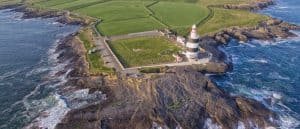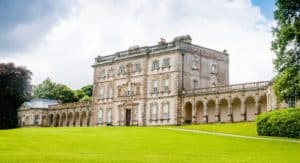Irish Folklore in Contemporary Literature: Its Influence and Resurgence

Updated On: April 22, 2024 by Maha Yassin
Irish folklore has long been a wellspring of inspiration for storytellers across various mediums, particularly in contemporary literature. These tales, rich in cultural nuance and steeped in myth, have transcended time, continuing to resonate with modern audiences. Our fascination with mythic heroes, fae creatures, and ancient deities comes alive within the pages of novels and stories, bridging the gap between the past and present. Irish culture and national identity are captured through the retelling of these stories, offering a lens through which we view the collective psyche and values inherent within the Emerald Isle.
The role of folklore in contemporary Irish literature is multifaceted, providing both a mirror to reflect societal concerns and a canvas for exploring the complexity of human experience. Through the integration of folklore, authors create works uniquely Irish yet universally relatable, underscoring themes of belonging, loss, and the quest for meaning. As elements of this rich oral tradition find new homes in contemporary narratives, they carry with them the echoes of Ireland’s cultural heritage and contribute to continuously shaping national identity.
Origins and Evolution of Irish Folklore

In exploring the rich tapestry that is Irish folklore, it’s crucial to uncover its roots and understand how it has adapted through centuries. Changes in society, writing, and historical influences have shaped these traditions into forms embraced in modern literature.
Historical Context
Irish folklore comprises many stories, myths, and legends deeply interwoven with Gaelic culture. The oral tradition served as the lifeblood of Irish heritage, passing knowledge and cultural values from one generation to the next. Historical narratives and mythical tales often conveyed societal norms and connected communities with their ancient past.
For a deeper insight into the historical significance of folklore in Irish culture, see Folklore in Irish Centre: Historical Context.
From Orality to Writing
Initially, Irish folklore thrived through the spoken word, with bards and storytellers playing a pivotal role in its preservation. The transition from orality to writing marked a significant evolution, with the advent of the written Gaelic language immortalising these once ephemeral narratives. This shift ensured the survival and proliferation of Irish tales, even extending beyond the confines of the island.
Discover how folklore evolved from spoken stories to written works at Oral Tradition and Modern Literature – University of Notre Dame.
Influence of Christianity and Colonisation
The arrival of Christianity in Ireland had a profound effect on the nation’s folklore. It merged with existing customs and beliefs, often incorporating pagan elements into Christian stories, thus creating a unique fusion that still characterises Irish tradition today. Later, colonisation by English forces introduced new dynamics, challenging and, at times, suppressing local culture. However, this underscored the significance of folklore as a pillar of national heritage, with its resilience reflecting the spirit of the Irish people.
To understand the complexities of these influences, refer to The Irish Folklore Commission 1935-1970: History, ideology … – OAPEN.
Key Elements of Irish Folklore

Irish folklore is a tapestry rich with mythical figures, entrenched beliefs, and intertwining realms of the natural and the supernatural. Each element plays a vital part in the cultural narratives passed down through generations.
Mythological Figures and Tales
Our literature often explores the nuanced stories and mythology that form the backbone of Irish cultural history. The Children of Lir, a tale woven with themes of enchantment and transformation, is a quintessential story that echoes the importance of familial bonds in Irish folklore. Similarly, the adventures and prowess of Cú Chulainn, from the Ulster Cycle, illustrate not only the heroics expected of mythological figures but also the deep social values they represent.
Folk Beliefs and Superstitions
Beliefs and superstitions have long guided the Irish people, shaping everything from daily practices to seasonal festivals. An example of such entrenched beliefs includes the reverence for fairies, often considered powerful beings that could bless or curse one’s life. Superstitions also dictate certain behaviours, such as the respect shown towards banshees, whose mournful wails were believed to foretell death.
The Natural and the Supernatural
Our folklore blurs the line between the natural world and the supernatural realm. This intersection is home to beings like leprechauns, whose stories are not simply children’s tales but narratives that encapsulate the complexity of the otherworld—a dimension parallel to our own. The enchanting landscapes of Ireland themselves are often imbued with mystical qualities, seen as gateways to these other realms where the mundane meets the magical.
Irish Folklore and Literature

In our exploration of the Irish literary landscape, it is evident that the tendrils of folklore are intricately woven into the fabric of both classical and contemporary Irish literature. This relationship spotlights a symbiotic dance between antiquity and modernity, reflecting the nation’s cultural heartbeat.
Classical Texts and Authors
Irish literature’s genesis is laced with the oral traditions of storytelling, a craft that scribes like Thomas Crofton Croker have deftly transcribed. His collections resonate deeply with Ireland’s rustic mystique, translating faerie tales and local lore into the written word. These texts serve as the backbone of our literary heritage, exemplifying the cultural vessel that literature can be.
W.B. Yeats, a venerated literary figure, was instrumental in fusing this rich folklore with the written word, rooting his poetry and drama in Ireland’s mythical ethos. His contributions not only glorified traditional narratives but also elevated the status of Irish folklore within the tapestry of world literature.
Contemporary Irish Writers
Transitioning from classical roots, our contemporary literary scene continues to echo with the whispers of folklore. Éilís Ní Dhuibhne is a remarkable voice, her prose intertwining modernity with the mystical threads of Irish storytelling. Her narratives are imbued with traditional motifs, remastered to resonate with contemporary audiences.
Similarly, Nuala Ní Dhomhnaill has masterfully employed the Irish language, grounding her work in a sense of cultural authenticity that hearkens to Ireland’s lyrical traditions. Her poetry remains a pulsating force within the literature, drawing upon mythological elements to inform and enrich her verse.
Literary Adaptations of Folklore
Amongst modern literary works’ oeuvre, folklore adaptations manifest in intriguing ways. Once the hearth told stories, they are now encapsulated in novels, poems, and plays. We see a deliberate transformation, with folklore acting as a muse to our writers, who reinterpret legendary tales for the new era.
These adaptations often focus not only on retelling the stories but also on delving deeper into the psyches of mythical figures, exploring the human conditions that these tales reflect. In essence, these contemporary literary ventures bridge the ethereal folk world and the tangible experience of today’s readership.
Folklore in Education and Knowledge Transmission

The transmission of Irish folklore within educational realms serves as a critical avenue for preserving tradition and enriching our collective knowledge. Through various institutions and archival efforts, the legacy of folklore continues to inform and inspire academic and communal learning.
Role in Schools and Universities
In schools and universities, the importance of folklore is increasingly recognised. Our educators integrate stories, myths, and legends into their curriculum to provide students with an appreciation of Ireland’s cultural heritage. Initiatives such as the Irish Folklore Commission have spearheaded educational programs that train future folklorists and promote the value of folklore in scholarly discourse.
Extensive projects conducted by dedicated individuals in academic settings delve into oral histories and literary texts to bring the vibrancy of Irish tradition into the classroom environment. University courses and public lectures often highlight the relevance of folklore to contemporary issues, demonstrating its enduring impact on society.
Folklore Archives and Research
As for the maintenance and study of folklore, archives play a pivotal part. Among these, the Schools’ Collection stands out, a rich repository of local history and traditional knowledge gathered from schoolchildren in national schools during 1937-38. Our researchers access these archives to uncover insights into the past, facilitating knowledge transfer across generations.
Folklore archives are not merely static collections but dynamic resources for ongoing research. Scholars meticulously scrutinise historical documents and utilise these archives to construct a more nuanced understanding of our national identity. The meticulous work of folklorists in these archives ensures that old teachings remain accessible and influential amidst the rapidly changing landscape of global education and culture.
Cultural and Social Functions of Folklore

Folklore is woven into the very fabric of society, influencing how we see ourselves, interact with each other, and interpret the world around us. It manifests through various elements, including customs, practices, and national identity, playing a pivotal role in societal functions.
Folklore in National and Cultural Identity
Folklore is a cornerstone in building a sense of national and cultural identity. Tales, myths, and legends from past times serve as a collective memory for a nation, often encapsulating the essence of a country’s spirit and history. For instance, our stories about leprechauns and banshees are not only entertaining; they’re an integral part of our Irish identity, informing both our understanding of ourselves and others’ perceptions of us.
Social Practices and Customs
Folklore significantly shapes our social practices and customs. The unwritten code guides our festivities, rituals, and everyday behaviours. Our folkloric traditions dictate the rhythms of seasonal celebrations and social gatherings, thus nurturing community cohesion and continuity. We cling to customs like dancing at a céilidh or observing St. Patrick’s Day, ensuring these customs persist through generations.
Political and Economic Factors
Folklore also has a role in political and economic areas of life. It can act as a soft power that influences political narratives, often employed to enhance national solidarity or support political agendas. Economically, the elements of folklore, such as crafts, music, and dance, can become commodities that drive tourism, contributing to the economic conditions by showcasing our cultural wealth.
Transmission and Transformation of Folklore

The perpetuation and evolution of folklore are rooted in the oral tradition and its journey through the ages, adapting to the pulses of modernity. At this core is the transformation and storytellers passing down tales from generation to generation.
Storytelling Tradition
The art of storytelling, a cornerstone of the oral tradition, has been the primary vehicle for transmitting folklore. Skilled storytellers breathe life into tales, ensuring generational shifts in listeners and tellers don’t diminish their essence.
Generational Shifts
As members of a dynamic culture, we witness continuous transformation. Stories, once conveyed by elders around the fire, now find new paths to their audience, morphing from generation to generation.
Adaptation in Modernity
Modernity has introduced various media enabling folklore’s reach beyond the spoken word. The essence of Irish tales is preserved, even when transmuted into contemporary novels or digital narratives.
Folklore and the Arts

Folklore permeates through Irish contemporary culture, particularly within the arts. Our discussion spotlights how the timeless traditions of music and dance, alongside visual arts, continue to echo Ireland’s rich heritage.
Music and Dance
Music and dance are integral expressions of Irish folklore, with a repertoire ranging from lively jigs to poignant ballads. Traditional Irish music remains at the heart of the country’s cultural identity, with instruments like the fiddle, uilleann pipes, and bodhrán drum providing distinct sounds that resonate at folklore festivals. The Clancy Brothers and Tommy Makem have been instrumental in bringing Irish music to a global audience, entwining folk narratives with modern sensibilities.
Dance, too, tells a story of its own. Irish step dance, popularised worldwide by shows like Riverdance, draws upon time-honoured steps passed down through generations. It embodies a unique blend of precision and vivacity, capturing the essence of Ireland’s folklore on stages both at home and internationally. The dance’s popularity supports the idea that traditional forms remain vital and influential within the framework of contemporary performing arts.
Visual Representations
Folklore is often a recurring motif in visual arts, inspiring both fine art and literature to delve into Ireland’s mystical past. Contemporary visual artists embrace and re-imagine folkloric themes, encapsulating the otherworldliness and enchantment of Irish mythology. The gothic home, a frequent subject in Irish culture, portrays the darker shades of folklore with its haunted spaces and phantom tales, as highlighted in the art that reflects the common trope of home as a strange space.
The interplay between art and folklore revives traditional motifs and fosters dialogue with modern narratives, shaping new interpretations that resonate within contemporary society. Folklore’s presence in visual mediums extends beyond the canvas—murals in urban landscapes and multimedia exhibitions further showcase how deeply ingrained these tales are in the Irish consciousness.
Through music, dance, and visual arts, the arts serve as a vibrant channel for folklore to continue influencing and informing our understanding of Irish culture.
Preservation of Irish Folklore

We understand that preserving Irish folklore is crucial to maintaining our national identity and cultural heritage. By safeguarding the tales and traditions passed down through generations, we foster a connection to our past that continues to influence contemporary literature and culture.
The Role of Institutions
The Irish Folklore Commission has been instrumental in systematically collecting and preserving our nation’s folklore. Established in 1935, it aimed to secure the oral tradition of Ireland for future generations. The fruits of its labour are an invaluable resource for scholars and enthusiasts, consisting of manuscripts and recordings that truly capture the essence of Irish cultural heritage.
Community Initiatives and Cultural Heritage
Community-led initiatives play a pivotal role in the preservation of Irish folklore. Local groups and societies are often at the forefront, organising events and fostering environments where traditions can be shared and celebrated. By embracing our folklore within communities, we ensure it remains a living tradition, actively enriching our cultural heritage.
Influence of Folklore on Contemporary Ireland
In examining the role of folklore, we find that it significantly impacts both popular culture and tourism in Ireland, intertwining with the national identity and cultural processes.
Folklore in Popular Culture
In contemporary Ireland, folklore has transcended its traditional boundaries, permeating popular culture and literature. Modern storytellers and artists often draw upon iconic tales such as “The Children of Lir” or “Cú Chulainn” to craft narratives that resonate with issues pertinent to today’s society. The integration of folklore in various artistic expressions—be it film, literature, or music—serves as entertainment and reaffirms and evolves Irish national identity. For instance, the dichotomy of the old and the new is explored through Gothic literature, where motifs from folklore are reimagined in a contemporary context, engaging with themes of home and identity.
Tourism and Folklore
Tourism in Ireland is intricately linked with the country’s rich folklore. Storytelling, once a way to pass down history and culture, has become a vital part of the tourism experience; visitors are keen to hear tales that give insight into Ireland’s historical landscape. Places steeped in mythical history such as the Giant’s Causeway or Newgrange, see an influx of tourists, drawn by the allure of living myths. Prominent cultural sites not only offer a glimpse into the country’s past but are also a driving force in the locality’s economy, as seen with the success of the Irish Centre in promoting folklore. Our culture and traditions are showcased and commercialised through festivals, performances, and guided tours, framing both the cultural process and the ever-evolving story of Ireland in the global context.
Debate and Critical Perspectives

Irish folklore has long been a fertile ground for debate within contemporary literature, spanning issues from national identity to authenticity. We seek to dissect these debates, understanding how they shape the dialogue around literary works that draw from Ireland’s rich folkloric tradition.
Authenticity and Commercialisation
The interplay between authenticity and commercialisation is a contentious issue in the modern literary world. As Irish folklore is utilised in literature, concerns arise about whether these representations remain true to their origins or are reshaped for mass appeal. Irish writers occasionally tread this fine line, navigating between preserving the integrity of folklore and reaching a broader audience. Myles na gCopaleen, through his characteristically satirical works, highlighted this tension, often critiquing the commodification of Irish culture.
Academic Critiques
Irish folklore in contemporary literature has been subject to rigorous critiques within the academic sphere. Scholars scrutinise how these literary works contribute to constructing or deconstructing national identity. There have been analyses on whether literary parody undermines traditional narratives or affirms them. We acknowledge the ongoing debate as academics question the impact and intentions behind modern reinterpretations of folklore, especially considering Ireland’s complex historical and cultural backdrop.
Frequently Asked Questions

In exploring the constantly evolving tapestry of literature, we find that Irish folklore’s deep roots and mythical narratives continue to weave into contemporary storytelling.
How is Irish folklore integrated into modern literary works?
Irish folklore is a foundation for thematic depth and narrative richness in modern literature, providing unique settings and compelling plot devices that resonate with a global audience.
Which Irish folktales have influenced contemporary storytelling?
Tales such as “The Children of Lir,” a story detailing the transformation and tribulations of four siblings turned into swans, have left an indelible mark on contemporary storytelling by offering motifs of transformation and endurance.
What role does mythology play in present-day Irish culture?
Mythology remains a potent force in shaping Ireland’s cultural identity, where ancient legends and mythical figures continue to inspire a sense of wonder and inform national consciousness.
Who are the prominent characters from Irish myths prevalent in today’s literature?
Characters like Cú Chulainn and Fionn mac Cumhaill have transcended centuries in today’s writings, embodying heroic qualities and offering readers a link to Ireland’s storied past.
What significance does Celtic mythology hold in current literary trends?
Celtic mythology serves as a wellspring of inspiration for narratives that explore themes of heroism, nature’s enchantment, and the intersection of the physical and spiritual worlds.
How do contemporary writers draw upon Ireland’s legendary beings and lore?
Contemporary writers tap into the vast repository of Ireland’s beings, such as leprechauns and banshees, and the rich lore surrounding them to create stories that resonate with tradition and modern sensibilities.






